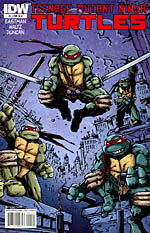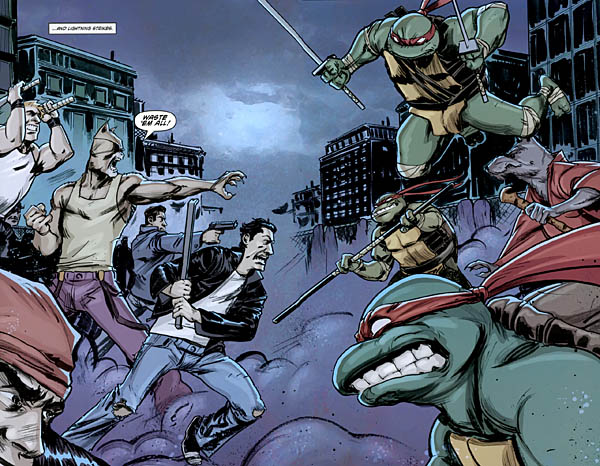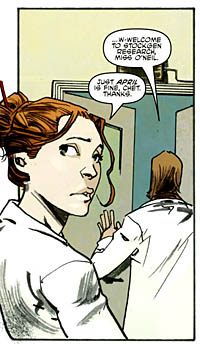 Story and layouts by Kevin Eastman
Story and layouts by Kevin Eastman
Story and script by Tom Waltz
Art by Dan Duncan
32 pages, color
Published by IDW
Teenage Mutant Ninja Turtles is one of those comics where a surprisingly high number of people in the world know who the characters are, but few actually know the original incarnation. That’s the one created by Kevin Eastman and Peter Laird in 1984 through a self-published comic, and which might startle people only familiar with their mid-’80s animated series, or the live-action movies from the ’90s, or even the Archie Comics version based off of the cartoon. Unlike all of the spin-offs, the original was a dark, brooding, and somewhat violent story; now, over a quarter of a century later, they’ve been rebooted again, and this new incarnation lends itself quite strongly to that original vision of the characters.
In this reset of the characters, the turtles have abandoned a lot of the childlike goofiness that got added to the property when it was aimed at children. Catchphrases, jokes, even the four different-colored headbands are all abandoned as the comic slips back to those early stories, where personalities and weapons are how you told the four apart, and in general the Turtles were living a secretive, dangerous, grim life. Eastman teams up with Tom Waltz to plot out a story that begins in media res, with three of the Turtles working with their sensei Splinter as they fight a street gang led by a new cat-villain named Old Hob, even as Raphael has struck out on his own.

 It’s a solid if slightly short opening; we see how the Turtles are operating in the present day, while also getting glimpses of their new origin. Instead of getting splashed by radioactive material (in a nod to the Daredevil comic’s first issue), they’re now test subjects from a local lab; presumably it’s where the mutated Old Hob character comes from, and with quite possibly additional humanoid animals around the corner. And while we see old characters April O’Neil and Casey Jones here, they’ve each got new roles as well, even if those appearances are brief for now. My only worry is that in general the comic feels slightly short; things are barely getting moving when it comes to a conclusion, and I can’t help but feel like Eastman and Waltz are relying at least a bit on nostalgia for the original Teenage Mutant Ninja Turtles to carry readers through to the next issue.
It’s a solid if slightly short opening; we see how the Turtles are operating in the present day, while also getting glimpses of their new origin. Instead of getting splashed by radioactive material (in a nod to the Daredevil comic’s first issue), they’re now test subjects from a local lab; presumably it’s where the mutated Old Hob character comes from, and with quite possibly additional humanoid animals around the corner. And while we see old characters April O’Neil and Casey Jones here, they’ve each got new roles as well, even if those appearances are brief for now. My only worry is that in general the comic feels slightly short; things are barely getting moving when it comes to a conclusion, and I can’t help but feel like Eastman and Waltz are relying at least a bit on nostalgia for the original Teenage Mutant Ninja Turtles to carry readers through to the next issue.
Dan Duncan draws over layouts from Eastman, and I’m overall pleased with the end result. Duncan’s art reminds me of a mixture between artists like Jim Mahfood and Rick Leonardi; there’s a blocky, simple look to the characters but we then get those interesting squiggles in April’s hair, or the ridiculously cute original forms of the turtles as they motor around their terrarium. Eastman’s layouts serve Duncan well when it comes to the fight scene that opens the comic; it’s energetic and easy to follow, even when shifting from one Turtle to the next with each panel. The overall look might be a little cheerier than people would expect based on the script, but it tells the story well enough that I think he’s a good choice.
IDW is in the midst of a big Teenage Mutant Ninja Turtles re-launch; not only do they have this reboot of the comic, but around the corner are two hardcover collections of Eastman and Laird’s original eleven issues (plus the four one-shots that came out around the same time, and all of which are fully restored). When I first heard of IDW bringing all of this into print, my initial thought had been to make sure to pick up the hardcovers. Now that I’ve read this first issue of the reboot, I’m entertained enough to come back for a second look. I’d like the pacing to get moving a bit faster, but for now the added hint of nostalgia is enough to make me interested. There’s no "cowabunga!" or "turtle power!" rallying cries here (save for a sidelong thumbing of the nose at the former), and that’s the way I like my Turtles.
